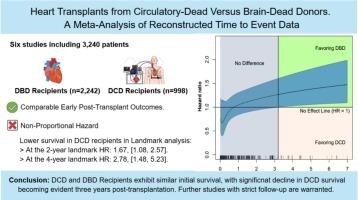Survival after heart transplants from circulatory-dead versus brain-dead donors: Meta-analysis of reconstructed time-to-event data
IF 3.6
2区 医学
Q2 IMMUNOLOGY
引用次数: 0
Abstract
Background
Heart transplantation (HTx) using donors after circulatory death (DCD) has the potential to significantly boost overall transplant rates. This study aims to reconstruct data from individual studies comparing survival between HTx from DCD recipients and donation after brain (DBD) recipients.
Methods
MEDLINE, Embase, Scopus, were searched up to August 2024. We included studies that reported a Kaplan-Meier summary of survival comparing DCD and DBD HTx. Digitization of the Kaplan-Meier curves and reconstruction of individual patient data followed by survival analysis that was conducted using R software.
Results
Six studies including a total of 3240 patients (2242 DBD and 998 DCD) were included in the final analysis. There was no significant difference in the overall survival rates between DCD and DBD patients (Hazard Ratio (HR): 1.01, 95 % CI [0.81–1.25], P = 0.91). However, the proportional hazard assumption was violated, deeming such results inconclusive. Time-varying flexible parametric model revealed a significantly declining survival in DCD recipients 3 years after surgery. Landmark analyses further suggest this declining trend in the DCD group at the two-year landmark (HR: 1.67, p = 0.021) and the four-year mark (HR: 2.78, p = 0.002). However, data beyond 6 years is limited. Evidence comparing direct procurement and normothermic regional perfusion is scarce, with no significant survival differences observed.
Conclusion
This meta-analysis shows that, despite similar early survival outcomes, DCD heart transplants showed a trend towards a lower long-term survival, with the difference becoming evident around three years post-transplantation. These findings highlight the need for enhanced monitoring and optimized post-transplant care in DCD recipients. Further studies with strict and long-term follow-up are warranted to confirm these results.

循环死亡与脑死亡供者心脏移植后的生存:重建时间-事件数据的荟萃分析
背景:循环死亡(DCD)后使用供体进行心脏移植(HTx)有可能显著提高总体移植率。本研究旨在重建比较DCD受者HTx和脑后捐赠(DBD)受者HTx存活率的个体研究数据。方法检索至2024年8月的medline、Embase、Scopus数据库。我们纳入了报告了比较DCD和DBD HTx的Kaplan-Meier生存总结的研究。Kaplan-Meier曲线的数字化和个体患者数据的重建,随后使用R软件进行生存分析。结果6项研究共纳入3240例患者,其中DBD 2242例,DCD 998例。DCD和DBD患者的总生存率差异无统计学意义(危险比(HR): 1.01, 95% CI [0.81-1.25], P = 0.91)。然而,违反了比例风险假设,认为这些结果不具有决定性。时变柔性参数模型显示DCD患者术后3年生存率显著下降。里程碑分析进一步表明,DCD组在两年里程碑(HR: 1.67, p = 0.021)和四年标记(HR: 2.78, p = 0.002)时呈下降趋势。然而,6年以上的数据有限。比较直接获取和常温区域灌注的证据很少,没有观察到明显的生存差异。本荟萃分析显示,尽管早期生存结果相似,但DCD心脏移植的长期生存趋势较低,在移植后3年左右差异变得明显。这些发现强调了加强监测和优化DCD受者移植后护理的必要性。需要进一步的研究和严格的长期随访来证实这些结果。
本文章由计算机程序翻译,如有差异,请以英文原文为准。
求助全文
约1分钟内获得全文
求助全文
来源期刊

Transplantation Reviews
IMMUNOLOGY-TRANSPLANTATION
CiteScore
7.50
自引率
2.50%
发文量
40
审稿时长
29 days
期刊介绍:
Transplantation Reviews contains state-of-the-art review articles on both clinical and experimental transplantation. The journal features invited articles by authorities in immunology, transplantation medicine and surgery.
 求助内容:
求助内容: 应助结果提醒方式:
应助结果提醒方式:


